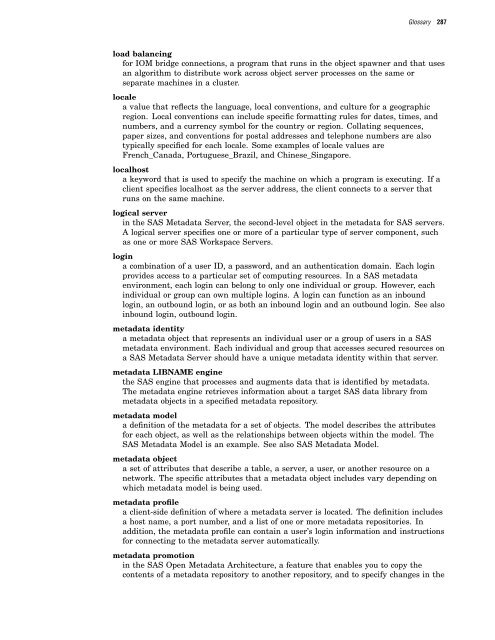SAS 9.1.3 Intelligence Platform: System Administration Guide
SAS 9.1.3 Intelligence Platform: System Administration Guide
SAS 9.1.3 Intelligence Platform: System Administration Guide
Create successful ePaper yourself
Turn your PDF publications into a flip-book with our unique Google optimized e-Paper software.
Glossary 287<br />
load balancing<br />
for IOM bridge connections, a program that runs in the object spawner and that uses<br />
an algorithm to distribute work across object server processes on the same or<br />
separate machines in a cluster.<br />
locale<br />
a value that reflects the language, local conventions, and culture for a geographic<br />
region. Local conventions can include specific formatting rules for dates, times, and<br />
numbers, and a currency symbol for the country or region. Collating sequences,<br />
paper sizes, and conventions for postal addresses and telephone numbers are also<br />
typically specified for each locale. Some examples of locale values are<br />
French_Canada, Portuguese_Brazil, and Chinese_Singapore.<br />
localhost<br />
a keyword that is used to specify the machine on which a program is executing. If a<br />
client specifies localhost as the server address, the client connects to a server that<br />
runs on the same machine.<br />
logical server<br />
in the <strong>SAS</strong> Metadata Server, the second-level object in the metadata for <strong>SAS</strong> servers.<br />
A logical server specifies one or more of a particular type of server component, such<br />
as one or more <strong>SAS</strong> Workspace Servers.<br />
login<br />
a combination of a user ID, a password, and an authentication domain. Each login<br />
provides access to a particular set of computing resources. In a <strong>SAS</strong> metadata<br />
environment, each login can belong to only one individual or group. However, each<br />
individual or group can own multiple logins. A login can function as an inbound<br />
login, an outbound login, or as both an inbound login and an outbound login. See also<br />
inbound login, outbound login.<br />
metadata identity<br />
a metadata object that represents an individual user or a group of users in a <strong>SAS</strong><br />
metadata environment. Each individual and group that accesses secured resources on<br />
a <strong>SAS</strong> Metadata Server should have a unique metadata identity within that server.<br />
metadata LIBNAME engine<br />
the <strong>SAS</strong> engine that processes and augments data that is identified by metadata.<br />
The metadata engine retrieves information about a target <strong>SAS</strong> data library from<br />
metadata objects in a specified metadata repository.<br />
metadata model<br />
a definition of the metadata for a set of objects. The model describes the attributes<br />
for each object, as well as the relationships between objects within the model. The<br />
<strong>SAS</strong> Metadata Model is an example. See also <strong>SAS</strong> Metadata Model.<br />
metadata object<br />
a set of attributes that describe a table, a server, a user, or another resource on a<br />
network. The specific attributes that a metadata object includes vary depending on<br />
which metadata model is being used.<br />
metadata profile<br />
a client-side definition of where a metadata server is located. The definition includes<br />
a host name, a port number, and a list of one or more metadata repositories. In<br />
addition, the metadata profile can contain a user’s login information and instructions<br />
for connecting to the metadata server automatically.<br />
metadata promotion<br />
in the <strong>SAS</strong> Open Metadata Architecture, a feature that enables you to copy the<br />
contents of a metadata repository to another repository, and to specify changes in the
















